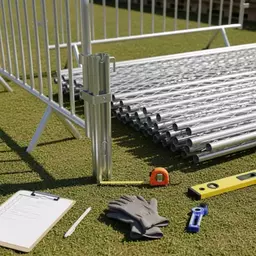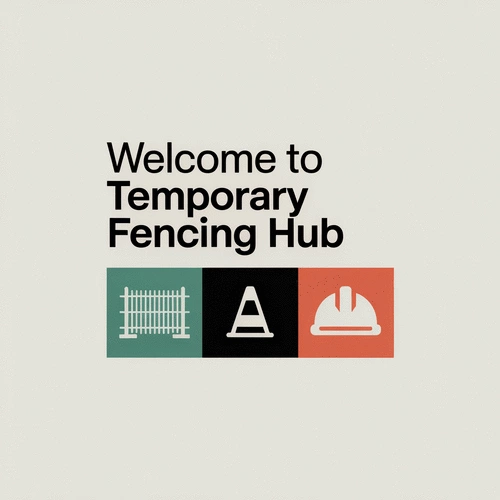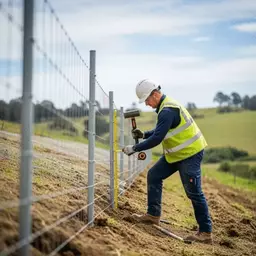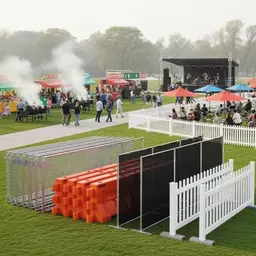Temporary fencing plays a crucial role in ensuring safety and compliance at construction sites and events. By understanding the relevant standards and regulations, you can significantly enhance the safety of your project. Let’s explore some essential takeaways from the insights shared in this article.
What You Will Learn
- Compliance with AS 4687-2022: Understanding this framework is vital for meeting safety regulations related to temporary fencing.
- Key Standards: Familiarize yourself with durability, height regulations, and anti-climb features to select compliant fencing options.
- WHS Guidelines: Stay updated on Workplace Health and Safety guidelines to ensure all safety measures are effectively implemented.
- Regular Inspections: Conduct weekly fencing inspections to ensure safety and compliance, preventing potential risks.
- Importance of Signage: Proper safety signage not only informs but also demonstrates commitment to compliance, enhancing public safety.
Australian Temporary Fencing Standards & Key Compliance Metrics
These visuals highlight the crucial aspects of temporary fencing in Australia, focusing on standards and compliance requirements.
Overview of Australian Temporary Fencing Standards
- Durability: Must withstand wind and impact.
- Height Regulations: Minimum heights for visibility.
- Anti-climb Measures: Features to deter climbing.
Key Compliance Requirements
- Fence Height: 1.8 to 2.4 meters.
- Strength: Robust materials for physical stress.
- Wind Resistance: Withstand strong winds.
- Anti-climb Features: Deter unauthorized access.
Installation & Maintenance Best Practices
- Recommended Height: Minimum 1.8 meters.
- Inspection Frequency: At least once a week.
- Professional Consultation: Recommended for compliance.
Fencing Regulations & Safety Signage
- Signage Compliance: AS 1319 standards.
- Visibility: Clear and legible from a distance.
- Regular Checks: Ensure signs remain intact.
Understanding the Importance of Temporary Fencing Safety in Australia
Temporary fencing is an essential component in ensuring the safety and security of construction sites and event environments across Australia. With increasing regulations and standards, it’s crucial to understand frameworks like AS 4687-2022, which sets out the safety requirements for temporary fencing systems. These guidelines not only protect the public and workers but also help in maintaining order during events, making adherence to these standards vital for any project.
In my experience with Temporary Fencing Hub, I've seen firsthand how vital it is for businesses, builders, and event organizers to grasp the significance of compliance. With the right fencing in place, risks are minimized, and everyone can enjoy a safer environment.
Overview of Australian Temporary Fencing Standards
The Australian temporary fencing standards are designed to ensure that all installations provide the necessary safety measures for protecting both people and property. Key aspects of these standards include:
- Durability: Fencing must withstand various environmental challenges, such as wind and impact.
- Height regulations: Minimum heights are specified to ensure visibility and prevent unauthorized access.
- Anti-climb measures: Features designed to deter climbing and enhance security.
By familiarizing yourself with these standards, you can confidently select fencing solutions that not only meet legal requirements but also provide peace of mind.
Key Compliance Requirements for Construction and Event Sites
To ensure compliance with Australian regulations, there are several key metrics that temporary fencing solutions must meet. These include:
- Fence Height: Minimum height specifications vary but usually range from 1.8 to 2.4 meters.
- Strength: Fencing materials must be robust enough to withstand physical stress.
- Wind Resistance: Structures need to be capable of withstanding strong winds, especially in exposed locations.
- Anti-climb Features: These features deter unauthorized access, enhancing security.
Understanding these requirements can help you avoid costly compliance issues down the line, ensuring that your project runs smoothly.
Role of Workplace Health and Safety (WHS) in Temporary Fencing
Workplace Health and Safety guidelines play a crucial role in shaping the requirements for temporary fencing in Australia. These guidelines ensure that all safety measures are adequate and effectively implemented on site. For instance, fencing must not only be compliant with physical standards but also align with the broader WHS regulations that govern site safety, as outlined by WorkSafe Victoria's guidelines on construction site security fencing.
In my experience, staying updated on WHS regulations is essential for effective site management. It helps contractors and site managers recognize their responsibilities in maintaining a safe working environment, aligning with resources like the Safety Share on Temporary Fencing from the South Australian Department for Infrastructure and Transport.
Pro Tip
To enhance the safety and compliance of your temporary fencing, consider conducting a pre-installation site assessment. This proactive approach allows you to identify specific challenges related to your environment, such as uneven terrain or high-traffic areas, ensuring that the fencing is not only compliant but also effectively protects your site and its visitors.
Addressing Common Questions about Temporary Fencing Compliance
Frequently Asked Questions
Here are some frequently asked questions regarding temporary fencing standards and compliance:
- What is AS 4687-2022?
AS 4687-2022 is the Australian standard that outlines the safety requirements for temporary fencing systems, ensuring they are durable, secure, and safe for public and worker interaction. - What are the key compliance requirements for temporary fencing?
Key requirements include specific fence heights (typically 1.8 to 2.4 meters), robust material strength, adequate wind resistance, and anti-climb features to prevent unauthorized access. - How often should temporary fencing be inspected?
Temporary fencing should be inspected regularly, with a minimum frequency of once a week, to ensure it remains secure, stable, and compliant with safety standards. - What role do WHS guidelines play in temporary fencing?
WHS guidelines ensure that temporary fencing installations not only meet physical standards but also integrate effectively into the broader site safety management plan, protecting workers and the public. - What are the requirements for safety signage on temporary fencing?
Safety signage must comply with AS 1319 standards, be clearly visible and legible from a distance, and communicate potential hazards effectively. Regular checks are required to ensure signs remain intact and unobstructed.
Frequently Asked Questions on Installation and Maintenance
When it comes to temporary fencing, I often receive numerous questions from clients and readers. Understanding these installation and maintenance aspects is crucial for ensuring compliance and safety at your site. Here’s a rundown of some frequently asked questions:
- What is the recommended height for temporary fencing? Most standards recommend a minimum height of 1.8 meters to effectively deter unauthorized access.
- How often should I inspect the fencing? Regular inspections, at least once a week, ensure the fencing remains secure and compliant.
- What types of signage are necessary? Clear safety signage should be displayed to indicate restricted areas and ensure public awareness.
- Can I install temporary fencing myself? While DIY installation is possible, I recommend consulting with professionals to ensure compliance with local regulations.
By addressing these common queries, I hope to empower you with the knowledge necessary for effective temporary fencing management. Remember, proper installation and maintenance can significantly enhance safety at your construction or event site!
Understanding Fencing Regulations and Safety Signage
It's vital to recognize the various fencing regulations in place to maintain compliance. The right signage plays an essential role in this. Not only does it inform the public of potential hazards, but it also demonstrates your commitment to safety and legal standards. Here are some critical points to consider:
- Ensure all signage complies with AS 1319, which outlines requirements for safety signs.
- Signs must be clearly visible and legible from a distance to effectively communicate safety messages.
- Include information about the fencing's purpose and any potential hazards associated with the site.
- Regularly check that all signage remains intact and unobstructed throughout the duration of the fencing installation.
By adhering to fencing regulations and prioritizing safety signage, you can significantly reduce risks and enhance the compliance of your temporary fencing solutions.
Recap of Compliance Importance and Next Steps
Reinforcing the Value of Adhering to Temporary Fencing Standards
As we come to the end of this section, it’s important to reiterate the value of compliance when it comes to temporary fencing. Adhering to the established standards not only protects your site but also safeguards the people who interact with it. By following the guidelines discussed, you minimize legal risks and contribute to a safer environment.
Next Steps: Consulting Standards and Suppliers
Now that you have a clearer understanding of temporary fencing compliance, I encourage you to take the next steps. Consult the relevant standards, and don’t hesitate to reach out to suppliers who can provide you with the right fencing solutions tailored to your needs. At Temporary Fencing Hub, we’re here to help you navigate these decisions confidently. Your commitment to compliance is essential for the safety and success of your projects!
Recap of Key Points
Here is a quick recap of the important points discussed in the article:
- Temporary fencing is essential for safety and security at construction sites and events in Australia.
- Adhering to Australian standards like AS 4687-2022 is crucial for compliance and risk minimization.
- Key compliance requirements include height regulations, strength of materials, and anti-climb features.
- Regular inspections and clear safety signage are vital for maintaining compliance and enhancing safety.
- Consulting with experts and suppliers can help ensure you select appropriate fencing solutions for your specific needs.









